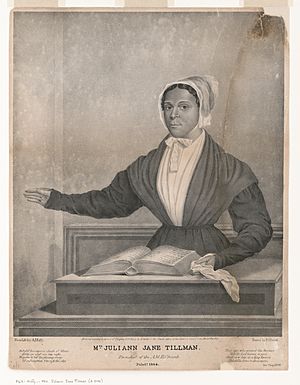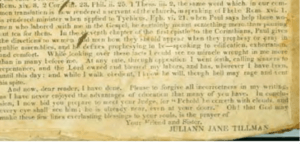Juliann Jane Tillman facts for kids
Juliann Jane Tillman was an important American preacher. She was part of the African Methodist Episcopal Church (AME Church). She is famous for a special portrait of her made in 1844. This portrait is kept in the Library of Congress today. Historians often look at it when they study women preachers from the 1800s.
Contents
Juliann Jane Tillman's Famous Portrait
This special portrait is titled "Mrs. Juliann Jane Tillman, Preacher of the A.M.E. Church." It was created by Alfred Hoffy and printed in Philadelphia. In the picture, Tillman looks right at you. She is making a gesture as if she is speaking. She seems to be telling people to get ready for a future event mentioned in the Bible.
Many copies of this portrait were made. This helped the AME Church share its message with more people. It also shows how popular Juliann Jane Tillman was at the time.
About Juliann Jane Tillman's Life
We do not know much about Juliann Jane Tillman's personal life. In 1837, she was quoted in a religious newspaper. She said she had doubts about preaching at first. Other church leaders also did not want her to preach.
But she said an angel visited her many times. The angel held a scroll that said, "Thee I have chosen to preach my gospel without delay." After these visits, she decided to preach. She was never officially made a minister.
Women Preachers in the AME Church
After Jarena Lee became the first female preacher in the AME Church, other women followed. Juliann Jane Tillman was one of these influential women. At first, the church was not sure about women preaching.
But women like Lee, Tillman, Julia Foote, and Rachel Evans were very good speakers. They convinced male ministers like Bishop Richard Allen and Bishop William Paul Quinn. Some ministers even welcomed these women into their churches. They helped pay for their travel as traveling preachers. These women played a big role in helping the church grow before the Civil War.
The AME Church allowed women to share their faith and teach. However, they could not become church leaders for over 100 years. Historian Aston Gonzalez believes Tillman's portrait shows how she kept her religious leadership. This was important because some male AME leaders spoke out against women preaching in the 1840s.
Another historian, Curtis D. Johnson, points out something different. In the Northern states, Black men and women wanted to make their communities stronger. They also wanted to end slavery. This shared goal meant there was less opposition to Black women like Tillman preaching in public. This was different from how white women preachers were treated.
Juliann Jane Tillman's Lasting Impact
Juliann Jane Tillman was one of the few women of her time who worked as a preacher. She helped open doors for future generations of African American women. These women then built connections between churches and community groups.
Tillman's portrait has been shown in several Library of Congress exhibits. These include "The African American Odyssey: A Quest for Full Citizenship" and "Religion and the Founding of the American Republic." Her portrait was also part of a traveling Smithsonian exhibit. This exhibit was called "Climbing Jacob's Ladder: The Rise of Black Churches in Eastern American Cities, 1740-1877." In 2007, Juliann Jane Tillman's portrait was even featured in the Library of Congress "Women Who Dare" calendar.



